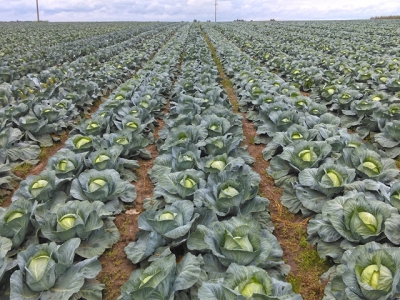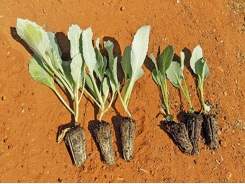Getting the land ready for cabbages

The first consideration when preparing land for cabbage is to get the soil’s nutrient content right.
Cabbage grown on raised beds.
With the high input costs involved, it’s foolhardy not to fertilise according to a soil analysis. This costs little and is often done gratis by your fertiliser supplier. Also, correcting the nutrient level at this stage will benefit subsequent crops.
Cabbage can be grown in slightly acidic soil, but it’s always better to try to get as close to a water pH level of 6,5 to 6,8 as possible. If your soil analysis calculates pH on the potassium chloride (KCl) basis, add one point to get the approximate water pH. In other words, a KCl pH of 5,5 would be close to a water pH of 6,5. A pH on the low side is likely to produce a molybdenum deficiency, which makes phosphate less available to the plant. In this case, work very finely ground lime into the soil. Do this well in advance of planting the crop, as the soil takes time to stabilise.
Most soils in South Africa are high in magnesium which should preferably be in balance with calcium. So, like most of our farmers, you will probably need calcitic lime. If you are in an area with a low level of soil magnesium, you should use dolomitic lime. Consult your fertiliser adviser about this. Cattle and poultry manure benefit microbial life and soil structure, and are excellent for stimulating plant growth.
Where I live, the cost of feedlot manure is R100/t, delivered. Assuming a nitrogen content of 1% and a moisture content of 40%, the nitrogen content alone will pay for each ton used. Manure also usually contains 0,4% to 0,5% phosphorous and up to 4% potash. The quantity of manure to apply will vary according to the type. Use about 30t/ha of cattle manure, 10t/ha of egg layer manure and about 15t/ha of broiler litter. The fertiliser value of the latter can vary, though.
How to work the soil
The more one works the soil, the faster its structure and organic content breaks down. The golden rule is to till only as much as necessary to get the job done. Small clods and crumbly soil improve water penetration and be less likely to crust after heavy rain. For the highest yield, space the rows about 60cm apart, leaving the odd row out for the tractor operating the spray rig.
The rows can be in the form of shallow ridges or on flat ground. Use raised beds 1,6m to 1,8m apart (from centre to centre) if there is a drainage problem; these reduce the chance of standing water damaging the roots. The beds should be angled to remove excess water from the land after heavy rain. Where the soil is well drained, raised beds will reduce yield. This is because the furrows between beds take up too much room, reducing the plant population.
Irrigation methods
Furrow irrigation is suitable where there is sufficent water. Although this method may seem rather primitive, it requires a great deal of skill. Getting the correct fall and distance between feeder furrows to suit the soil type takes experience. Nevertheless, you can get excellent results with lower input costs. When I started vegetable farming, I would grow 60ha of cabbage this way and end up with a yield of up to 150t/ha.
The easiest irrigation method, which is very effective and precise, is the centre pivot. My advice is to install this as soon as you can afford it. If you are using pipes and sprinklers, opt for the solid set system, where you simply open valves as you need to. It is more expensive but far better than carting pipes over the land. All farmers need to cut down on labour as much as possible and, in any case, the work involved in moving pipes does enormous damage to the soil and crop.
Drip irrigation can also work, especially where water is scarce.
Related news
Tools

Phối trộn thức ăn chăn nuôi

Pha dung dịch thủy canh

Định mức cho tôm ăn

Phối trộn phân bón NPK

Xác định tỷ lệ tôm sống

Chuyển đổi đơn vị phân bón

Xác định công suất sục khí

Chuyển đổi đơn vị tôm

Tính diện tích nhà kính

Tính thể tích ao



 Start fertilising your cabbage before planting
Start fertilising your cabbage before planting  Choose the right cabbage seedlings
Choose the right cabbage seedlings